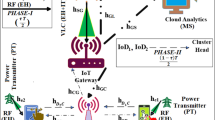Abstract
This study focuses on the use of Light Emitting Diodes (LEDs) for lighting, incorporating Visible Light Communication (VLC) technology for data transmission. The Internet of Things (IoT), an inventive technology can connect physical objects to the digital world through VLC. In smart environments, IoT interacts with Wireless Sensor Networks (WSN) and Mobile Ad-Hoc Networks (MANET), enhancing user experience and economic viability. This interaction forms new MANET-IoT systems in VLC-based networks, offering increased user mobility, energy saving and reduced network deployment costs. This work compares the performance of Light Fidelity technology of VLC and Radio Frequency (RF) technology, considering factors such as data rate, Bit Error Rate, and power consumption. The focus extends beyond energy efficiency to emphasize the creation of a hazard-free environment in the near future by using LEDs in indoors and outdoors. The obtainable outcomes of this investigation is energy consumption using global MANET and WSN in IoT VLC based system, marking a significant step towards providing reliable services over internet. Packet Delivery Rate is estimated for 100 node counts of Cluster Nodes Reinforcement Scheme in comparison with Reliable Data Transmission Model and EA-based Imperialist Competitive Algorithm (MANET) schemes in the work.










Similar content being viewed by others
References
F. Zafar, D. Karunatilaka, R. Parthiban, Dimming schemes for visible light communication: the state of research. IEEE Wirel. Commun. 22(2), 29–35 (2015). https://doi.org/10.1109/MWC.2015.7096282
A. Kar, A. Kar, New generation illumination engineering-an overview of recent trends in science & technology. First Int. Conf. Autom. Control Energy Syst. (ACES) (2014). https://doi.org/10.1109/ACES.2014.6807997
A.Z. Suriza, S. Akter, M. Shahnan, Dimming techniques for visible light communication system. Indones. J. Electr. Eng. Comput. Sci. 10(1), 258–265 (2018). https://doi.org/10.11591/ijeecs.v10.i1.pp258-265
A. Celik et al., A top-down survey on optical wireless communications for the internet of things. IEEE Commun. Surv. Tutor. (2023). https://doi.org/10.1109/COMST.2022.3220504
C. Hongd, W. Chunhui, L. Hongle, C. Xiongbin, G. Zongyu, C. Shigang, W. Qin, Advances and prospects in visible light 130 communications. J. Semicond. (2016). https://doi.org/10.1088/1674-4926/37/1/011001
A. Chizari, M. V. Jamali, J. A. Salehi, A. Dargahi, Designing a dimmable OPPM-based VLC system under channel constraints, in 10th International Symposium on Communication Systems, Networks and Digital Signal Processing (CSNDSP) (2016), https://doi.org/10.1109/CSNDSP.2016.7573964
W. Uemura, T. Kitazawa, A hybrid modulation method for dimming in visible light communication. Int. J. Compu. Netw. Commun. (IJCNC) (2018). https://doi.org/10.5121/ijcnc.2018.10404
F. Zafar, V. Kalavally, M. Bakaul, R. Parthiban, Experimental investigation of analog and digital dimming techniques on photometric performance of an indoor visible light communication (VLC) system. Fourteenth Int. Conf. Solid State Lighting LED-based Illum. Syst. (2015). https://doi.org/10.1117/12.2187367
Z. Wang, W.-D. Zhong, Yu. Changyuan, J. Chen, C.P.S. Francois, W. Chen, Performance of dimming control scheme in visible light communication system. Opt. Express 20(17), 18861–18868 (2012). https://doi.org/10.1364/OE.20.018861
J.-h Choi, E.-B. Cho, Z. Ghassemlooy, S. Kim, C.G. Lee, Visible light communications employing PPM and PWM formats for simultaneous data transmission and dimming. Opt. Quant. Electron. 47, 561–574 (2014). https://doi.org/10.1007/s11082-014-9932-0
ITU‐T/Recommendation Y.2060. Overview of the Internet of Things [Internet]. 2012‐06. Available from: http://www.itu.int/itu‐t/recommendations/rec.aspx?rec=Y.2060 [Accessed: 2016‐06‐10]
S.S. Aarti, Tyagi, study of MANET: characteristics, challenges, application and security attacks. Int. J. Adv. Res. Comput. Sci. Softw. Eng. 3(5), 252–257 (2013)
R. Balakrishna, Z. Hussain, A survey on manets‐types, characteristics, applications and protocols used, in National Conference on Frontiers and Advances in Information Science and Technology FAIST. ed. by R. Balakrishna, L. Naveen, U.G. Nandish, (13; 23–24 May, 2013), Bangalore, India: RRCE
P. Nayak, R. Agrawal, S. Verma, Energy aware routing scheme for mobile ad hoc network using variable range transmission. Int. J. Ad Hoc Sens. Ubiquitous Comput. 3(4), 53–63 (2012). https://doi.org/10.5121/ijasuc.2012.3406
S. Agrawal, M. Lal Das, Internet of Things—A Paradigm Shift of Future Internet Applications. in Nirma University International Conference on Engineering, (8–10 Dec, 2011, 2011), Ahmedabad, Gujarat: IEEE pp. 1–7. https://doi.org/10.1109/NUiConE.2011.6153246
O. Vermesan, P. Friess, eds. Internet of Things: Converging Technologies for Smart Environments and Integrated Ecosystems, 1st edn. (Aalborg, Denmark: River Publishers, 2013) p. 364
P. Suresh., J. Vijay Daniel, V. Parthasarathy, R.H. Aswathy, A state of the art review on the internet of things (iot) history, technology and fields of deployment. in International Conference on Science Engineering and Management Research (ICSEMR), (27–29 Nov, 2014; Chennai. IEEE; 2014), pp. 1–8. DOI: https://doi.org/10.1109/ICSEMR.2014.7043637
D. Miorandi, S. Sicari, F. De Pellegrini, I. Chlamtac, Internet of things: vision, applications and research challenges. Ad Hoc Netw. 10(7), 1497–1516 (2012). https://doi.org/10.1016/j.adhoc.2012.02.016
B. Bhuyan, H. Kumar Deva Sarma, N. Sarma, A. Kar, R. Mall, Quality of service (QoS) provisions in wireless sensor networks and related challenges. Wirel. Sens. Netw. 2, 861–868 (2010). https://doi.org/10.4236/wsn.2010.211104
Author information
Authors and Affiliations
Corresponding author
Additional information
Publisher's Note
Springer Nature remains neutral with regard to jurisdictional claims in published maps and institutional affiliations.
Rights and permissions
Springer Nature or its licensor (e.g. a society or other partner) holds exclusive rights to this article under a publishing agreement with the author(s) or other rightsholder(s); author self-archiving of the accepted manuscript version of this article is solely governed by the terms of such publishing agreement and applicable law.
About this article
Cite this article
Vijayalakshmi, B.A., Pasupathi, C., Subhashini, P. et al. Internet of things connecting digital world through visible light communication. J Opt (2024). https://doi.org/10.1007/s12596-024-01808-y
Received:
Accepted:
Published:
DOI: https://doi.org/10.1007/s12596-024-01808-y




